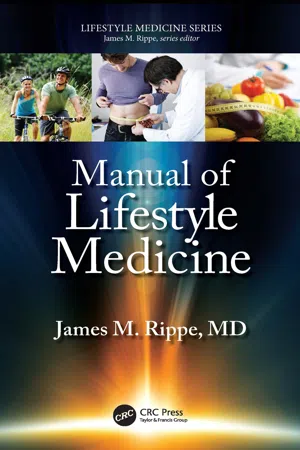
- 300 pages
- English
- ePUB (mobile friendly)
- Available on iOS & Android
Manual of Lifestyle Medicine
About this book
The fundamental premise of lifestyle medicine is that daily habits profoundly impact health and quality of life both in the short-term and long-term. Written by lifestyle medicine pioneer and cardiologist , Dr. James Rippe, this book provides a clinically oriented, evidence-based look into key lifestyle factors and how to prescribe them to individuals of all ages.
Written for professionals working at all levels of medical and healthcare practice, this manual summarizes the major components of lifestyle medicine, from physical activity and nutrition to weight management and the avoidance of tobacco products. It includes clinical guidelines and practices for using lifestyle medicine principles to lower the risk of numerous chronic conditions. The manual also provides information on behavior change, approaches to lowering the risk of dementia, treatment of addictions and injury prevention.
Features:
- Explains how lifestyle medicine can reduce the risk of heart disease, diabetes, cancer, osteoarthritis, dementia and many other chronic conditions.
- Chapters begin with bulleted key points and conclude with a list of clinical applications.
- Provides strategies for prescribing physical activity and helping patients improve their nutrition, lose weight if necessary and reduce stress.
- Includes clinically relevant sections on "Treating Addiction, Preventing Injury and Improving Brain Health".
This book provides updated and clinically targeted summaries used in conjunction with Dr. Rippe's major academic textbook Lifestyle Medicine, now in its third edition, published by CRC Press/Taylor & Francis Group, LLC.
Frequently asked questions
- Essential is ideal for learners and professionals who enjoy exploring a wide range of subjects. Access the Essential Library with 800,000+ trusted titles and best-sellers across business, personal growth, and the humanities. Includes unlimited reading time and Standard Read Aloud voice.
- Complete: Perfect for advanced learners and researchers needing full, unrestricted access. Unlock 1.4M+ books across hundreds of subjects, including academic and specialized titles. The Complete Plan also includes advanced features like Premium Read Aloud and Research Assistant.
Please note we cannot support devices running on iOS 13 and Android 7 or earlier. Learn more about using the app.
Information
1 Lifestyle Challenges and Opportunities
Key Points
- The study of how daily habits and actions impact on long- and short-term health and quality of life is the core concept in lifestyle medicine.
- There is no longer any serious doubt that positive habits and actions significantly impact on reduction of risk of disease as well as its treatment.
- Such modalities as increased physical activity, proper nutrition, weight management, avoidance of tobacco products, and sleep and stress reduction, all significantly impact both quality of life and likelihood of developing disease.
1.1 Introduction
Consensus Statements from Various Organizations which feature Lifestyle Modalities
|
Rippe JM. Lifestyle Medicine (3rd edition). CRC Press (Boca Raton), 2019. |
1.2 What Is Lifestyle Medicine?
Table of contents
- Cover
- Half-Title
- Series
- Title
- Copyright
- Dedication
- Contents
- Preface
- Acknowledgments
- Author Bio
- Chapter 1 Lifestyle Challenges and Opportunities
- Chapter 2 Nutrition in Lifestyle Medicine
- Chapter 3 Physical Activity and Health
- Chapter 4 Behavioral Change
- Chapter 5 Lifestyle Medicine and Cardiovascular Disease
- Chapter 6 Diabetes, Prediabetes, and Metabolic Syndrome
- Chapter 7 Cancer Prevention and Treatment
- Chapter 8 Obesity and Weight Management
- Chapter 9 Pulmonary Medicine
- Chapter 10 Obstetrics and Gynecology
- Chapter 11 Lifestyle Medicine and Brain Health
- Chapter 12 Women’s Heath
- Chapter 13 Immunology and Infectious Disease
- Chapter 14 Pediatrics
- Chapter 15 The Practice of Lifestyle Medicine
- Chapter 16 Lifestyle Medicine for the Older Adult Population
- Chapter 17 Heath Promotion
- Chapter 18 Injury Prevention
- Chapter 19 Substance Abuse and Addiction
- Chapter 20 Public Policy and Environmental Support for Lifestyle Habits and Practices
- Chapter 21 Lifestyle Medicine around the World
- Chapter 22 The Future of Lifestyle Medicine
- Index